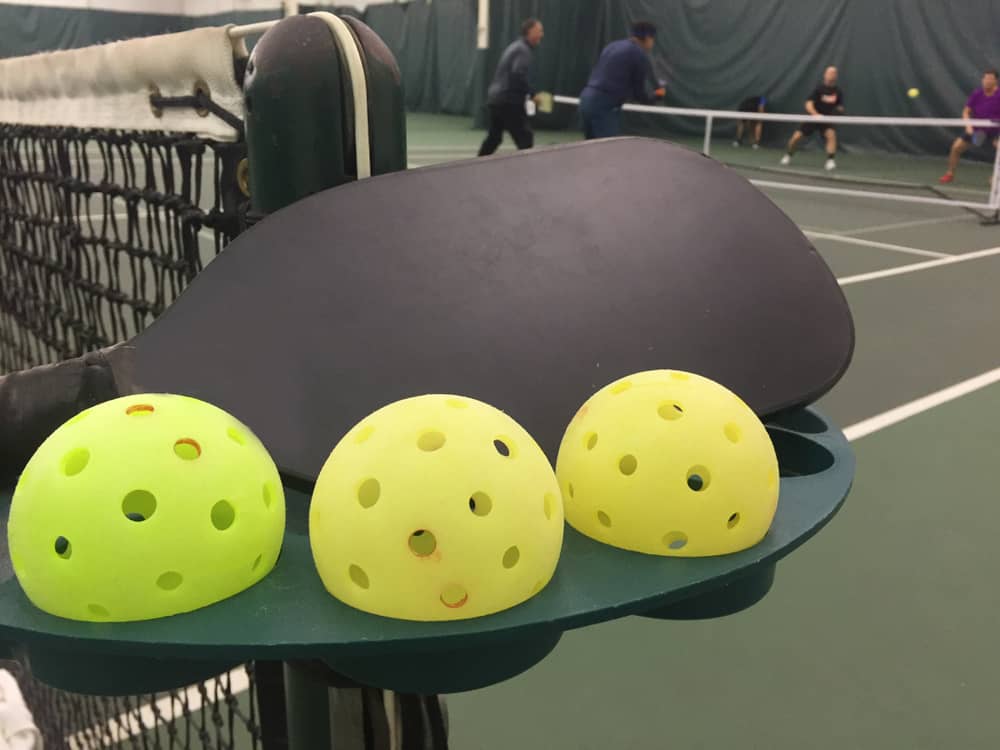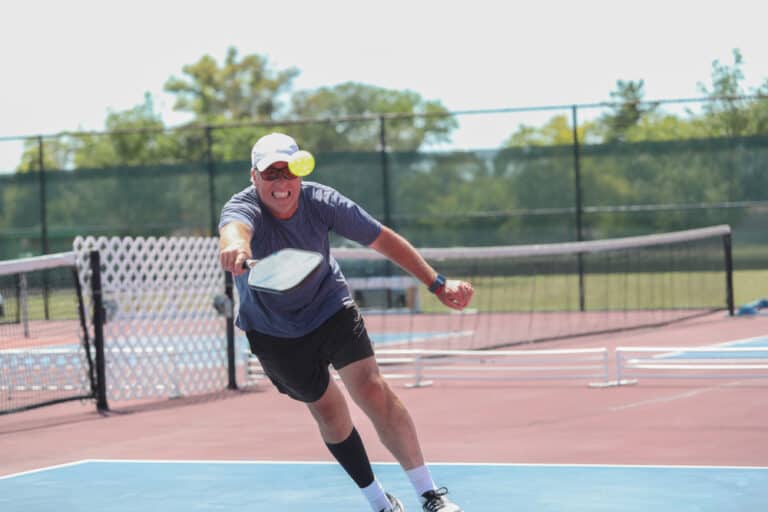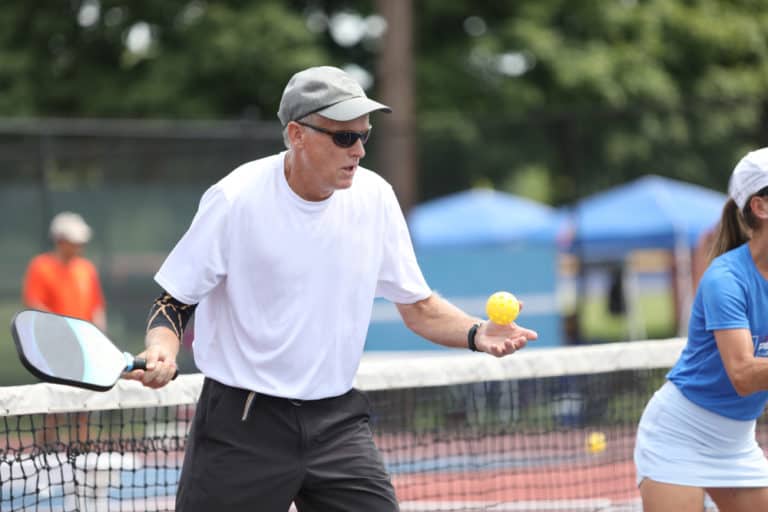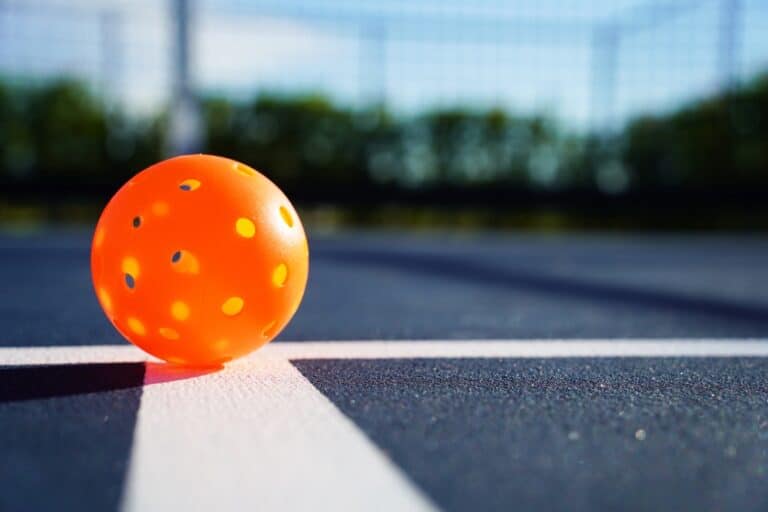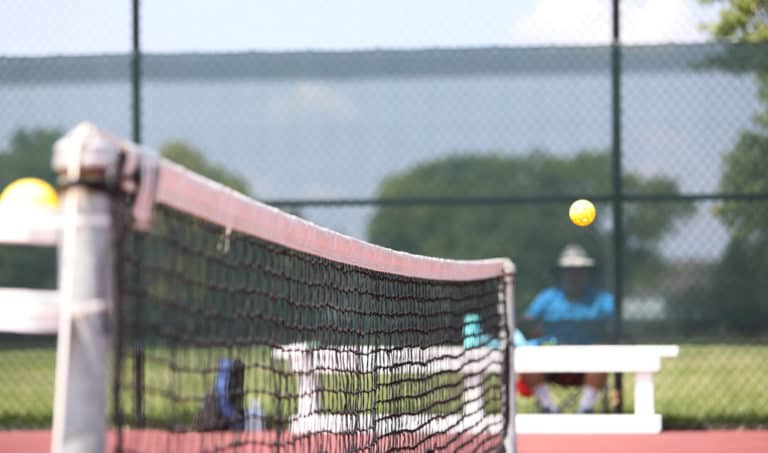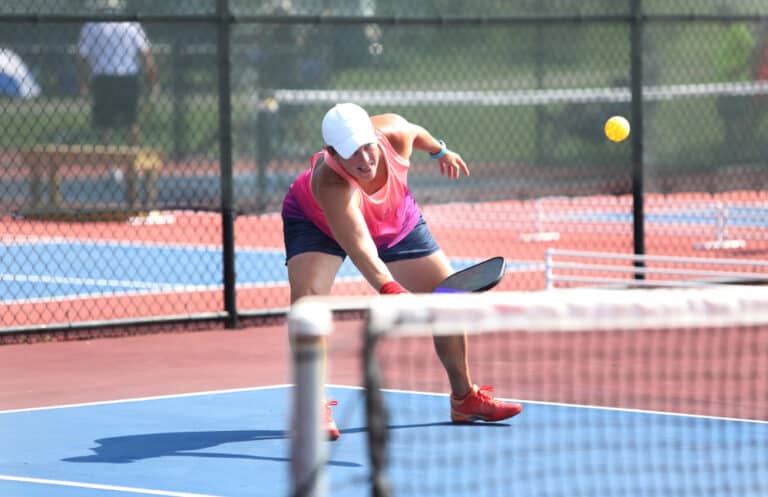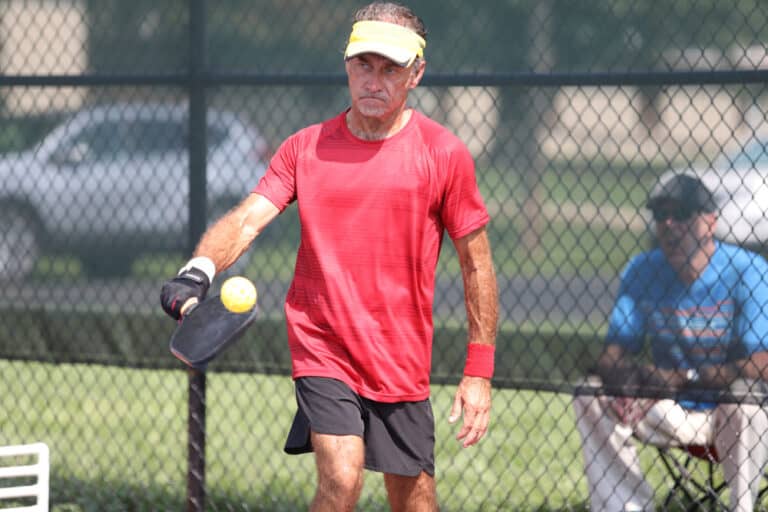How Do You Practice Pickleball Indoors?
While pickleball began life as an outdoor sport, it can also be played on indoor courts, and even if you don’t have a lot of space, you can still practice inside your house. Weather can be a real challenge to play pickleball outdoors, so if the wind is blowing and the rain is falling, you might wonder what you can do to get in some extra practice. You can definitely practice pickleball indoors if you have a bit of space indoors and a clear wall to bounce a ball off.
When practicing pickleball indoors, make sure you have a clear open space and remove any breakables from the area. You will need a span of about eight-nine feet and a clear wall. Use a softer ball rather than a standard wiffleball, practice your stroke groove and improve hand-eye coordination.
Obviously, few of us players have access to a standard indoor pickle court in our house, but you can still practice your shots, your volleys, and hand-eye coordination indoors. As long as you have a bit of open space and a soft foam ball to avoid damaging the walls, you can practice your technique and improve your stroke. Even without a wall, there are a few other tricks you can use — and while you might not be able to strike hard, you’ll still find plenty of ways to improve your game as you go through what you need to practice pickleball indoors.
How do you practice pickleball indoors?
The popularity of pickleball grew throughout Covid-19, and the many lockdowns as people looked for new ways to keep themselves active and entertained with an outdoor sport. However, as with any outdoor sport, bad weather can disrupt your practice time and leave you frustrated. Still, there are also ways to practice pickleball if you’re stuck indoors.
If you’re unable to play outdoors because of bad weather, you can still get some pickleball practice indoors. I would suggest making sure you pick up a pickleball paddle set designed to be used indoors. These are usually a little lighter than standard outdoor sets, and the balls are more lightweight.
If that’s not an option, use your standard with a nice soft foam ball that won’t damage any of your indoor furniture or decorations. Try to choose a ball that is a bright color and easy to spot, as this will make indoor practice much easier. https://www.amazon.com/Tourna-12-Pack-Foam-Balls/dp/B07C4PQQ61
Get rid of any breakables that might be in the way before you start practicing, as even a soft foam ball could knock over a vase or ornament.
Depending on what’s available to you (and your DIY skills), you might be able to practice pickleball against a wall, by using a basic swingball setup, or even building yourself a mini-practice wall from plywood in your basement.
Whichever ultimately works for you, training indoors is an excellent way to increase your practice times and improve your fundamental skills and give you time to slow things down to work on your form.
Practicing Pickleball Indoors Against a Wall
Before you start your indoor practice, the first thing you need to do is make sure you have a suitable amount of space. I’d clear a section of about eight or nine feet to give you enough room to swing and strike. You want a space in front of a clear area of the wall where you can bounce your ball.
One thing you can do with practicing indoors is to concentrate on your static drop practice. This drop practice will help you correct any issues and improve your forehand form.
Grab a bucket of indoor balls and drop them one by one in a static forehand drop. This will bounce the ball at the exact height needed to practice your strike. You can use this technique to repeat the strikes and correct your form. As you know, repetition and practice will make your technique better, and even if you can’t get outdoors to play a game, this exercise will make a massive difference in your playing.
Another, more straightforward thing to do is to watch the ball as you hit it with your paddle against the wall; let it bounce once on the floor, then strike gently. There’s no need to hit the pickleball or foam ball hard; merely bounce it against the wall with each stroke.
This deceptively simple pickleball exercise is an excellent way to train your reactions and improve your hand and eye coordination. Gentle strikes help you to practice your dinks and rallies.
If you want to speed things up, volley the ball by striking before it hits the ground, and keep up a fast pace.
Practicing Pickleball Indoors Without a Wall
If you don’t have a wall to use indoors for practice, don’t despair, we have an excellent solution for you. Using a regular pickleball, thread some string through the holes to create a length of string long enough to hang the ball from your ceiling at the height of a pickleball racket.
Attach your string firmly to the ceiling so that the pickleball hangs over a clear area when you have enough space to move around. Using your pickleball paddle, you can strike the ball from either side with a backhand or forehand technique. By shifting and bouncing from side to side to recreate the feel of playing against an opponent, you stimulate muscle memory, get in some exercise, and work on your shuffle speed.
Because this swingball setup means you don’t need as much space as when you practice against a wall, there are no excuses for you not to practice getting in some repeated strikes, engaging muscle memory, and improving your serving techniques.
If the sound of a hard pickleball striking against the paddle is too loud or annoying for neighbors or other residents, string up a soft foam ball in the same way. Using a softer ball indoors will help avoid that sound of the constant hard strikes of a standard pickleball against the paddle that can cause so much tension with others!
Practicing Pickleball Indoors with a Tennis Rebounder
If you’re fortunate enough to have a lot of indoor space, perhaps in a basement room or a garage, you can get a little more active with your pickleball drills indoors and really strike the ball hard.
Use a tennis rebounder to allow you to practice your volleys, your underarm serves, and your overhand and underhand strikes. By using a rebounder, you can change the angle of the rebounder to train different kinds of shots. This way, you are not limited by having only a vertical surface, and you don’t need a partner with whom to train.
You can set your rebounder into the vertical position to train serves and volleys. By changing the angle and inclining the rebounder, you can practice as though the ball were coming back at you from a higher pitch, helping improve your underhand serves.
The valuable thing with an adjustable rebounder is that you can use it indoors or set it up outdoors if necessary, allowing you to find a space to practice your pickleball drills without going to a pickleball court.
You can buy a basic net rebounder on Amazon for $129.99 https://www.amazon.com/Rukket-Practice-Rebounder-Sports-Backboard/dp/B0821SRPYT/ or make your own.
DIY Pickleball Rebounder for Indoor Practice
The size of the rebounder you make for pickleball practice will depend on your needs and where you will be able to fit it. If you only have a small space for training, you can build yourself a small rebounder to work on your dink technique. If you’re looking to practice in a larger area such as a garage or basement, you can build a much larger pickleball rebounder/bounce wall, paint it, and section it with a net height to help you with training.
A small portable rebounder net is something you can make with only a few dollars worth of kit from a hardware store. A simple frame of interconnected PVC piping to support a bounce net will be perfect for dink training. Stretch the netting across the frame to provide a good rebounding surface.
You can even make a DIY rebounder with an easel and a large solid piece of plywood to serve as your ‘wall.’
If you have enough space and find you often can’t train outside due to bad weather, you might want to build a dedicated pickleball bounce wall.
Building your indoor pickleball wall will take some more work, but you’ll love the result.
DIY Pickleball Wall for Indoor Practice
Setting up your own pickleball wall in a space dedicated to your practice means you won’t have to worry about knocking over fragile items, marking paint with your balls, or annoying your partner or housemates with prolonged pickleball training sessions.
A garage or basement is ideal for your new indoor pickleball practice room, as there are a few things to consider before your go to the expense of buying your plywood and tarps.
You’ll need a hard surface, adequate space to practice (about ten feet across on the surface where you plan to build your wall – the area of a single court service), about seven feet clearance height above your ‘net’, and enough space for you to swing your paddle and move freely so you can practice.
You want to build a bounce wall because solid concrete walls don’t really provide the best bounce. Instead, you’ll hang a plywood wall. Use a small wedge at the bottom of the wall if you want to create a slight angle, to mimic the feel of a ball coming back at you from a little more height.
Measure the net height at 3 feet, and cover the area below this with a ‘bounce-deadening’ material to recreate the feel of hitting the net. You can use a tarp or a drop cloth to do this.
Mark off a perpendicular line on the floor about seven feet from your net. This line marks off your kitchen or non-volley zone. Depending on how ample your indoor space is, you might need a second line 15ft from your kitchen line to serve as the baseline.
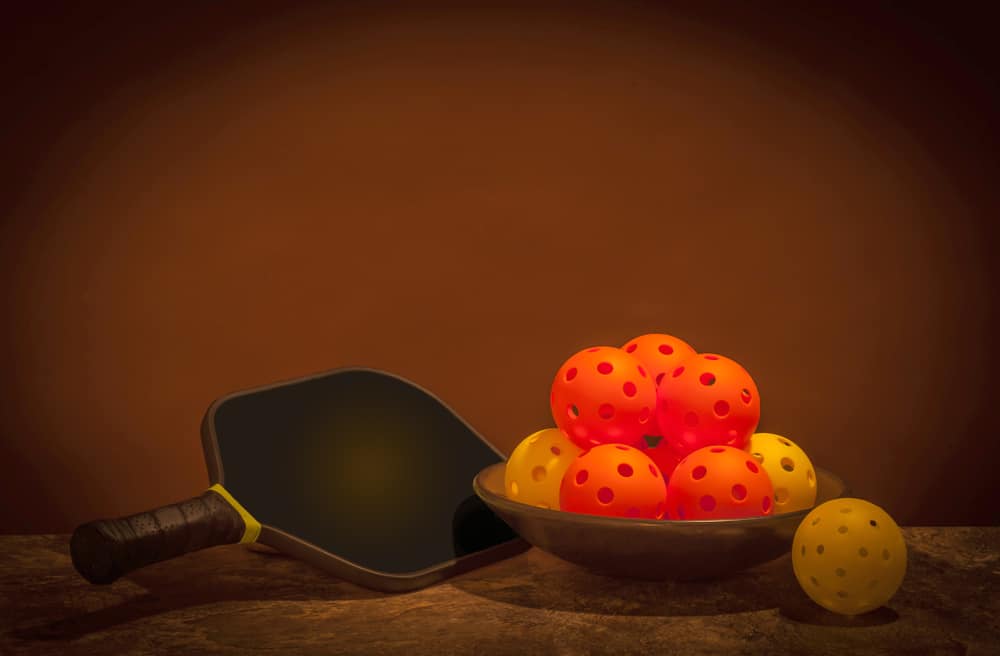
Practicing Pickleball on an Indoor Court.
If you have access to an indoor pickleball court, you will be able to practice more dynamic moves even without a partner.
Utilize the extra space available in an indoor court to practice your drills against the wall. If you usually only have the freedom to practice dink shots and soft underhand serve with a soft foam ball, then practice with a harder standard pickleball or wiffleball and work on improving more dynamic serves and shots.
The extra space also means you can focus on crosscourt serves, groundstrokes, or even overhead smashes.
A good drill for indoor pickleball training is starting with some dinks that go from the left to center to the right to warm up and get your muscles accustomed to switching between fore and backhand strokes. By switching it up with the direction of your serves, you train yourself to change quickly.
Improve your reactions skills, maneuverability, and reaction times by working on a series of volleys. Volleys are a great way to get your blood pumping and improve your decision-making as you decide whether to take high or low return shots at speed.
Increase the power of your serve by putting a lot of distance between yourself and the wall, forcing you to work on distance control and your drop shot—alternate these drills with drills close to the net.
Conclusion
When you can’t get to the court to practice, or it’s too windy or rainy to practice pickleball outdoors, there are a few ways you can work on drills and techniques indoors. Depending on space and noise constraints, you can use a soft foam ball against a wall to practice dinks and volleys, or, if you have more space, you can use a simple tennis rebounder or build a rebounder wall to practice faster strokes and serves. Either of these will help develop your hand-eye coordination and improve your agility for the game.

